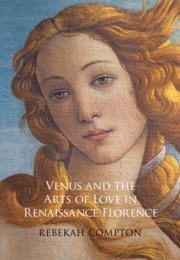Book contents
- Venus and the Arts of Love in Renaissance Florence
- Venus and the Arts of Love in Renaissance Florence
- Copyright page
- Dedication
- Contents
- Figures
- Acknowledgments
- Introduction
- One Golden Splendor
- Two Cultivating Complexions
- Three Sartorial Seduction
- Four Green Gardens
- Five Erotic Anatomy
- Six Maritime Treasures
- Conclusion
- Bibliography
- Index
Four - Green Gardens
Venus’ Verdant Virtues
Published online by Cambridge University Press: 04 March 2021
- Venus and the Arts of Love in Renaissance Florence
- Venus and the Arts of Love in Renaissance Florence
- Copyright page
- Dedication
- Contents
- Figures
- Acknowledgments
- Introduction
- One Golden Splendor
- Two Cultivating Complexions
- Three Sartorial Seduction
- Four Green Gardens
- Five Erotic Anatomy
- Six Maritime Treasures
- Conclusion
- Bibliography
- Index
Summary
Venus’ lush green gardens, shady evergreen groves, and fragrant floral bowers in Sandro Botticelli’s paintings of Venus are the subject of Chapter 4. These verdant landscapes provided a place for romance, as celebrated in poetic descriptions of the locus amoenus and the goddess’s Cyprian gardens; however, they also offered curative properties to nourish and heal the mind, body, and spirit. This chapter explores these concepts in relation to the mediums and materials used by artists to create green places within the domestic interior, paying particular attention to the artistic and economic value of the green pigments derived from copper – a metal infused with Venus’ celestial virtues.
- Type
- Chapter
- Information
- Venus and the Arts of Love in Renaissance Florence , pp. 129 - 156Publisher: Cambridge University PressPrint publication year: 2021

